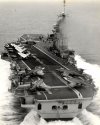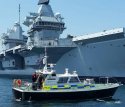The U.S. Navy’s top officer wants to end standing
patrols and transfer the mission to shore-based assets.
Chief of Naval Operations Adm. John Richardson said in no uncertain terms Tuesday that he wants the Navy off the tether of
patrols, a mission that has put a growing strain on the Navy’s hard-worn surface combatants, and shifted towards more shore-based infrastructure.
“Right now, as we speak, I have six multi-mission, very sophisticated, dynamic cruisers and destroyers -- six of them are on ballistic missile defense duty at sea,” Richardson said during his address at the U.S. Naval War College’s Current Strategy Forum. “And if you know a little bit about this business you know that geometry is a tyrant.
“You have to be in a tiny little box to have a chance at intercepting that incoming missile. So, we have six ships that could go anywhere in the world, at flank speed, in a tiny little box, defending land.”
Richardson continued, saying the Navy could be used in emergencies but that in the long term the problem demands a different solution.
“It’s a pretty good capability and if there is an emergent need to provide ballistic missile defense, we’re there,” he said. “But 10 years down the road, it’s time to build something on land to defend the land. Whether that’s AEGIS ashore or whatever, I want to get out of the long-term missile defense business and move to dynamic missile defense.”
The unusually direct comments from the CNO come amid growing frustration among the surface warfare community that the mission, which requires ships to stay in a steaming box doing figure-eights for weeks on end, is eating up assets and operational availability that could be better used confronting growing high-end threats from China and Russia.
The BMD mission was also a factor in degraded readiness in the surface fleet. Amid the nuclear threat from North Korea, the BMD mission began eating more and more of the readiness generated in the Japan-based U.S. 7th Fleet, which created a pressurized situation that caused leaders in the Pacific to cut corners and sacrifice training time for their crews, an environment described in the Navy’s comprehensive review into the two collisions that claimed the lives of 17 sailors in the disastrous summer of 2017.
Richardson said that as potential enemies double down on anti-access technologies designed to keep the U.S. Navy at bay, the Navy needed to focus on missile defense for its own assets.
“We’re going to need missile defense at sea as we kind of fight our way now into the battle spaces we need to get into,” he said. “And so restoring dynamic maneuver has something to do with missile defense.
The Navy has had some success with land-based BMD with its
in Romania, which uses what looks like a cruiser superstructure with SPY arrays and missiles to create a missile defense shield. Another AEGIS Ashore is planned for Poland in 2020 and last year
, which could relieve some of the pressure on 7th Fleet ships once operations.
AEGIS Ashore installations are run around the clock by three shifts of 11 personnel each.
Rotational Deployment Blues
Defense Secretary Jim Mattis has been outspoken about the need for the Navy to become less predictable and more agile to respond to an evolving security environment. Mattis thinks the kind of predictable rotational deployments that dispatch carriers to predictable locations such as the Persian Gulf.
Instead, Mattis wants the Navy to pursue a concept called “dynamic force employment,” having the Navy deploy at odd times and show up in unexpected places, all the while spending less time underway to preserve surge readiness for a major conflict.
But BMD missions work against that kind of unpredictability and consume an out-sized portion of readiness the Navy generates through its deployment model.
Because of the U.S. Navy’s standing commitments around the globe, the fleet has to have a constant forward presence. This means that for every ship that’s forward on deployment, there is a ship back in the states that has just come back from deployment and is in surge status, another ship that is in maintenance and unavailable, and still another ship that is in its training cycle and preparing to relieve the ship on patrol.
With six ships underway doing BMD, that means there are 18 ships tied up in the cycle preparing to do the mission.
“That’s a good chunk of the surface fleet,” said Bryan Clark, a retired submariner and analyst with the Center for Strategic and Budgetary Assessments who has studied this issue extensively.
Some of the decline in training and readiness has come from the increasing burden of BMD on the fleet, he said.
“Over time this is one of the places the Navy has made sacrifices in training and readiness,” Clark said. “Because of the high demand, when the [cruisers and destroyers] go into their training cycles they’ve had to do abbreviated versions of the work-ups that focus specifically on missile defense instead of training for the full range of missions those ships are capable of performing.”
And rotating forward deployed ships back to the states for repairs and overhaul is another burden on the force.
The Navy has four BMD destroyers forward deployed in Rota, Spain, which deployed between 2013 and 2014. But those ships were slated to rotate out after six years, a deadline that is rapidly approaching.
In January, then-Fleet Forces head Adm. Phil Davidson described the impact that rotation was having on the ships he needs to fill out carrier strike groups for deployment.
“We sent four destroyers with a certain capability over to Rota, with the idea that they were going to be there each about six years and we were going to replace them with four ships with better capability when that capability was aligned,” Davidson told the audience at Surface Navy Association’s annual conference. “I can tell you that the four ships I’ve got to send next, I’m already pulling them out of strike groups to do the modernization they need to go over there.”
“Then I’m going to get four ships back that then are going to require their docking availability and some modernization as well. Pretty soon this looks like eight ships that are out of the strike group rotation for three years. We’re going to need a bigger Navy to apply that kind of policy.”
The mission could be done for far less money and impact on the fleet from shore-based installations, said Thomas Callender, also a retired submariner and analyst with the Heritage Foundation.
“It takes, what, [33] sailors to run an AEGIS Ashore installation instead of 300 on a DDG?” he said. “And ultimately, if its on land, does it even need to be sailors that run it?”
 I am curious to know which way the Brazilians will turn next. ATLANTICO will give them a fleet flagship and allow their helicopters to deploy in force with the fleet, but what role will the employ her in? They have amphibious forces but they were not the central focus of the fleet previously. She is a highly capable ASW asset as she can operate ASW Helicopters, but unless the Brazilians buy a number of either AV-8Bs from the US (second hand of course) or raid the piggy bank for F-35Bs then the Brazilian Navy's fighter pilots will remain land locked with their shiny A-4s.
I am curious to know which way the Brazilians will turn next. ATLANTICO will give them a fleet flagship and allow their helicopters to deploy in force with the fleet, but what role will the employ her in? They have amphibious forces but they were not the central focus of the fleet previously. She is a highly capable ASW asset as she can operate ASW Helicopters, but unless the Brazilians buy a number of either AV-8Bs from the US (second hand of course) or raid the piggy bank for F-35Bs then the Brazilian Navy's fighter pilots will remain land locked with their shiny A-4s.
 I am curious to know which way the Brazilians will turn next. ATLANTICO will give them a fleet flagship and allow their helicopters to deploy in force with the fleet, but what role will the employ her in? They have amphibious forces but they were not the central focus of the fleet previously. She is a highly capable ASW asset as she can operate ASW Helicopters, but unless the Brazilians buy a number of either AV-8Bs from the US (second hand of course) or raid the piggy bank for F-35Bs then the Brazilian Navy's fighter pilots will remain land locked with their shiny A-4s.
I am curious to know which way the Brazilians will turn next. ATLANTICO will give them a fleet flagship and allow their helicopters to deploy in force with the fleet, but what role will the employ her in? They have amphibious forces but they were not the central focus of the fleet previously. She is a highly capable ASW asset as she can operate ASW Helicopters, but unless the Brazilians buy a number of either AV-8Bs from the US (second hand of course) or raid the piggy bank for F-35Bs then the Brazilian Navy's fighter pilots will remain land locked with their shiny A-4s.










